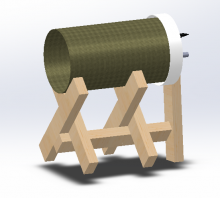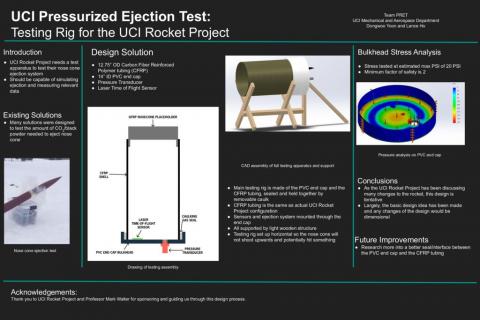Pressurized Recovery Ejection Tester
Background
As the Primary Test Rocket (PTR) of the UCI Rocket project nears completion, it was necessary to finalize the configuration of both the recovery system, specifically pertaining to the arrangement of the rigging of the recovery system, the interface between the skin and the nosecone extension, and the configuration and integration of the carbon dioxide ejection system with the existing avionics systems slated to be onboard the PTR. Therefore, the UCI Rocket Project has commissioned a testing device that would be able to test and finalize the factors mentioned above.
Goal And Objectives
The UCI Rocket project needs a test system able to recreate the ejection process of the nose cone and deployment of the parachute, as well as potentially testing different methods for mounting the nose cone onto the rocket. As such, The system must be able to measure and record test data.
We need to design, model, and produce a prototyping plan of a testing apparatus at full scale or scaled. It should be capable of withstanding multiple simulated ejection cycles, as well as being able to test different methods of nose cone and fuselage interface, different locations for mounting the carbon dioxide ejection system, measuring the velocity of the ejecta, shock load caused by the ejection, and finally be able to test various rigging configurations for the parachute assembly. The results obtained must be able to be obtained repeatedly with reasonable precision in order to ensure consistent functionality of recovery system design in the launch vehicle.
Concept Generation
The concepts for the main structure of the testing system were all very similar. The main idea surrounding them was to create a replica of the connecting part of the fuselage, and have a replacement bulkhead that will house the ejection system potentially some sensors. One of the concepts that was thought up can be seen just below.
While this concept was our inital design, we made many revisions after meeting with the UCI Rocket Project Team on multiple occaisions and receiving feedback on necessary components and availability of parts. We revised our final design to one that would be closer to the in-flight configuration, as it uses the same carbon fiber skin on the actual rocket. A drawing of the configuration is seen below.
Final Design
For the final design, the main body of the testing apparatus is made of the exact same tubing that the in-flight configuration will have. This is a 12.75 inch inner diameter carbon fiber reinforced polymer tubing. The length of the tubing itself is set to be 2 feet long, however this may change due to different parachute packaging in the actual rocket. The bulkhead will be a PVC end cap, drilled with a few holes to hold a couple sensors and the ejection system. The end cap and the tubing will be sealed together with removable caulk. The reasoning behind removable caulk is so that if the Rocket Project wishes to mount their own bulkhead, the seal can easily be removed and replaced. The sensors themselves will be a pressure transducer to measure the presure inside the space at the time of ejection, and the other will be a laser time of flight sensor that will be used to measure how far the nose cone ejects. The ejection system is the same as the on-board system, which will be a Raptor carbon dioxide ejection system with variable loading cartridges. All of this will be supported by a wooden support structure made of various wooden planks. The final assembly is seen below.
Team Contacts
Dongwoo Yoon: dongwoy@uci.edu
Lance Ho: lanceth@uci.edu
Sponsor/Advisor
Sponsor
UCI Rocket Project
Team Lead - Jorge Karam Padilla
Advisor
Mark Walter


